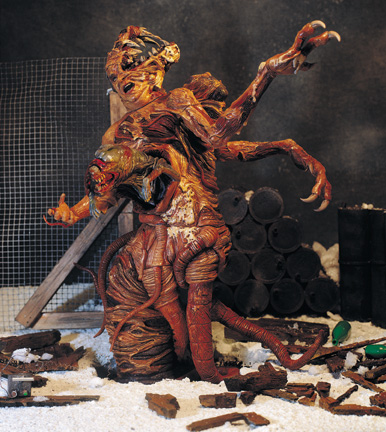
The third installment for Blake & Ian’s four-part series is Ian’s second selection, the 1982 classic creature flick The Thing, directed by John Carpenter andstarring Kurt Russell, Wilford Brimley & T. K. Carter.

Ian:
John Carpenter’s The Thing is a masterpiece of cosmic/body horror which viscerally manifests the alien abjection of sin. Through masterful use of freezing, tension-fraught atmosphere and brilliant (i.e. horrifyingly gory) special effects, Carpenter meditates on embodiment, identity, and paranoia with breathtaking results. The story, set in hostile Antarctica, follows a shape-shifting alien which can replicate the physiology and even the memories of everything (and everyone) it assimilates. Its arrival triggers an epidemic of suspicion and scapegoating as the scientists of Outpost 31 succumb to a menace that wears their faces.
In all of its grotesquerie, the Thing functions as an analogue for the phenomenon of sin. Sin, like the Thing, is an infection coming from outside yet making its home within, corrupting the design of created things at the molecular level. Neither has a form proper to its being because both are parasitic. Like the Thing, sin is defective mimesis; it distorts and degrades whatever it encounters, and its ravenous hunger knows no satisfaction. What is it that compels sin’s bottomless consumption, though? Sin is undivided and acts perfectly in accordance with its own being as nothingness: its sole raison d’être is the defilement and negation of creation. The narcissism of nothingness hungers to subject all that is not itself to its own degradation by replicating itself in deficient (though outwardly convincing) mimicries. In the same way, the Thing’s impulse to fight and survive is tethered to its single-minded need to absorb and proliferate. It is its own pointless purpose.

These concepts are still somewhat abstract, though; we witness their reality in gruesome detail as the Thing erupts into the isolated research facility. Indiscriminate in its targets, the Thing desecrates its victims’ bodies in a sickening mockery of what embodiment means: petals of flesh blossom from mutilated pulp; tentacles and spider legs sprout from nowhere in hideous metamorphoses that have to be seen to be believed. The life of the Thing resembles decomposition and defecation more than anything; its processes connote mutilation and death rather than shalom. The Thing makes a travesty of the image of God by reducing it to a playground of tissue and fluid, and this desecration of the body is the catalyst for abjection. According to Julia Kristeva, the abject is that which transgresses the safe boundaries we’ve placed between subject/object and self/other. The abject is “the eruption of the Real”, and its intrusion inspires horror and repulsion. The Thing, as unnameable transgressor, is abjection in the flesh, the borrowed flesh of a thousand species, turning insides out and counterfeiting selves as others.
These men of science freeze in terror at its monstrous incomprehensibility; their mouths hang agape, unable to deny the reality of what they see, however much they might wish to. The assimilator resists assimilation into their easy narrative of progress and mastery. Their assured view of the world is ripped to shreds by the impossible possibility butchering and rearranging them. That mass of dismembered flesh cannot be what I am, the characters insist in their terror; I am more than that. The Thing’s ability to mimic its victims casts a shadow on that humanist assumption, however: if it can copy so perfectly, what is there to distinguish these men from the impostor? How do we discern the fraudulent from the authentic? Who do I rely on to help me discern one from the other? “If I was an imitation, a perfect imitation, how would you know it was really me?” one of them asks. The Thing tightens the screws by implicating everyone as potential copies, brilliantly capitalizing on man’s proclivity to fragment into self-serving factions. What little unity they began the film with disintegrates as each character instinctively curves in on himself to preserve himself at any cost. With the alien impostor rampaging invisibly amongst them and no idea who they can trust, factions form, crumble, reassemble, and collapse.
 When Kristeva writes that abjection is a kind of narcissistic crisis, then, she’s more correct than she realizes: the abject reinforces narcissism in human subjects because sin itself is an ontologically empty narcissism of its own. The men of Outpost 31 fracture into dehumanized disunity as they steadily fall prey to this parasitic incarnation of narcissism. Ironically, the Thing’s undivided motivation to assimilate is an indictment against the survivors’ pathetic war of all against all, the triumph of faceless collectivism over atomistic individualism. Sacrificial corporate resistance could have possibly put an end to the Thing’s rampage but that doesn’t exist here. There’s nothing to anchor hope to and nothing to bind them together; no heroics, no solidarity of conviction, only frenzied determination to survive, and impersonal narcissism simply outlasts individuated narcissism in the long run. And on the outside chance someone does survive the attempt to destroy the Thing, can we be sure it’s defeated after all?
When Kristeva writes that abjection is a kind of narcissistic crisis, then, she’s more correct than she realizes: the abject reinforces narcissism in human subjects because sin itself is an ontologically empty narcissism of its own. The men of Outpost 31 fracture into dehumanized disunity as they steadily fall prey to this parasitic incarnation of narcissism. Ironically, the Thing’s undivided motivation to assimilate is an indictment against the survivors’ pathetic war of all against all, the triumph of faceless collectivism over atomistic individualism. Sacrificial corporate resistance could have possibly put an end to the Thing’s rampage but that doesn’t exist here. There’s nothing to anchor hope to and nothing to bind them together; no heroics, no solidarity of conviction, only frenzied determination to survive, and impersonal narcissism simply outlasts individuated narcissism in the long run. And on the outside chance someone does survive the attempt to destroy the Thing, can we be sure it’s defeated after all?
The Thing‘s ending is appropriately nihilistic, then. Man’s pretensions have met their match: American exceptionalism and modern science both have been weighed in the scales and found wanting when confronted by the Real. Radio silence from outside means that no Word of rescue has found its way in, and left to themselves the survivors of Outpost 31 will freeze in their distrust. The Antarctic waste reflects back the hopelessness of their predicament. Only the Christ can conclusively confront the abject and absorb its nothingness; only the Christ can negate the negation and restore distorted, degraded images.
Blake:
Whenever I watch The Thing, I end up wanting to revisit the early horror films of David Cronenberg which had a similar feel of invasion of our bodies by something outside of us, yet it seeks to take on our identity, it churns inside us and makes us manipulate ourselves and others. Like Ian said, sin is similar to the Thing, similar to the parasites in Cronenberg’s Shivers among others and it seeks to distort the original being, the original creation. It mimics us, but it is not us. It is something entirely other from us. And it is bent on destroying us.
 The interesting aspect of Ian’s idea about otherness and narcissism is that humanity is prone to disregarding, fearing, hating the “other” and turning in on themselves and those who look like them. Until those who look like them transform into something that becomes divisibly “other” then we, in turn, reject them as well. People who would rather rely on self-salvation and self-righteousness reject, fear, and hate God, on some level, because He is other. In a sense, man’s perception of the Thing and of God is similar because they are wholly other from who we perceive ourselves to be, independent and self-sufficient. We do not like giving over control to an “other”. The Thing was other in a way that would mimic us with near perfection, while causing us to decay–literally (as in the movie) and figuratively–on the inside.
The interesting aspect of Ian’s idea about otherness and narcissism is that humanity is prone to disregarding, fearing, hating the “other” and turning in on themselves and those who look like them. Until those who look like them transform into something that becomes divisibly “other” then we, in turn, reject them as well. People who would rather rely on self-salvation and self-righteousness reject, fear, and hate God, on some level, because He is other. In a sense, man’s perception of the Thing and of God is similar because they are wholly other from who we perceive ourselves to be, independent and self-sufficient. We do not like giving over control to an “other”. The Thing was other in a way that would mimic us with near perfection, while causing us to decay–literally (as in the movie) and figuratively–on the inside.
But God’s otherness is different from the mimicking of the Thing, because God is wholly other than us and, yet, He is us. The Gospel announces that the One who is other from us (God) doesn’t just mimic humanity but actually becomes human, to relate to and save us. This is precisely what divides cosmic horror writers like Arthur Machen (who was a Christian) from those like H. P. Lovecraft (who was an atheist). Lovecraft saw complete and hopeless invasion of the indifferent and wholly other beyond the void, whereas Machen saw a complete and hopeful invasion of a personal and wholly other God that ripped open the dark void, shone light, and became fully human, so that He might to become us. We, then, can take on His identity–instead of the other way around–as shown so profoundly in John Carpenter’s The Thing.
Below: A perfect retelling of The Thing with claymation cats by the very talented Lee Hardcastle.
[youtube=https://www.youtube.com/watch?v=BG33zECv8dc&w=600]

COMMENTS
2 responses to ““Strange Fascination, Fascinating Me”: John Carpenter’s The Thing (1982)”
Leave a Reply













Your posts this month, Blake and Ian, are the perfect use of the MBird platform. Thoughtful, theological, and well-written takes on horror films. If I was to make my own contribution based on my own recent viewing, I would write on Bernard Rose’s The Candyman.
Your post here has gotten my mind aflutter with wondering: what are my own beliefs about how sin works? About what sin is? About what the Bible says about sin and whether I jive with what the Bible says about it? Is sin some monster, some evil force, outside of ourselves, like both of you say that is hell bent on destroying/devouring us? Or is the monster us? Is sin inscribed in us in some way such that at this point in our ongoing creation, it isn’t helpful to say that it is something wholly outside us? Seems like when you personify sin, you can easily deny culpability. Perhaps we enjoy monster movies so much because then we can forget how much we are at fault for the sins of the world. Or perhaps secretly monster movies hold up a mirror to us if we have eyes to see (Dorian Gray style).
Wonderful post. Thanks!
I would identify sin as the monstrous, God-defying principle which simultaneously invades and subverts the good creation from without and within. The thrust of your comment covers every dimension of its reality, and I think it’s crucial we maintain the incommensurable tension between that outer/inner dynamic; we have to resist both Manicheanism and a more Boethian “evil as lack” approach, as each by themselves makes a reductionism of sin’s (simple/absurd) complexity. Your closing sentences are a gold mine of insight, and I think it’s important we look for our reflection in the monsters we fear on the silver screen but we also need to remember that there are monsters in the first place because the equilibrium of the originally good creation was marred by rebellion.